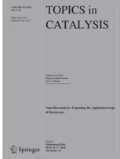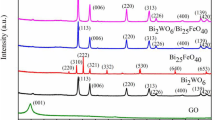Abstract
Novel highly visible-light active 1.0rGO–ZnBi2O4–Bi2S3 heterostructure photocatalysts with various weight percentages of Bi2S3 were successfully synthesized. First, the 1.0rGO–ZnBi2O4 catalyst was synthesized by a simple two-step oxidation–reduction and co-precipitation methods, followed by heating at 450 °C. Then, 1.0rGO–ZnBi2O4 was hydrothermally treated with Bi3+, and thiourea in ethylene glycol to obtain the 1.0rGO–ZnBi2O4–Bi2S3 heterostructure photocatalyst. The obtained 1.0rGO–ZnBi2O4–Bi2S3 heterostructure photocatalysts were characterized by X-ray diffraction, UV–Vis diffuse reflectance spectroscopy, scanning electron microscopy, X-ray photoelectron spectroscopy, and Raman spectroscopy. Photocatalytic studies were conducted using Indigo carmine and it was found that the heterostructure photocatalyst enabled an almost complete degradation of the pollutants. The enhanced catalytic activity of the 1.0rGO–ZnBi2O4–2.0Bi2S3 heterostructure photocatalyst is due to the homogeneous distribution of ZnBi2O4–2.0Bi2S3 over rGO as well as to the efficient electron-transfer from Bi2S3 to ZnBi2O4 and finally to rGO. More than 97% of Indigo carmine of 50 mg/L was degraded by 1.0rGO–ZnBi2O4–2.0Bi2S3 in 75 min of visible light irradiation. The reusability of the 1.0rGO–ZnBi2O4–2.0Bi2S3 was studied, and after four cycles, the Indigo carmine degradation efficiency decreased to 90%.The mechanism of the Indigo carmine degradation by the 1.0rGO–ZnBi2O4–2.0Bi2S3 catalysis likely consists of to two main processes: first, charge transfer prolongs the lifetime of the electron–hole pairs, and then the electron–hole pairs participate in the reactions that produce free radicals.






Similar content being viewed by others
References
Chen C, Cai W, Long M, Zhou B, Wu Y, Wu D, Feng Y (2010) ACS Nano 4:6425
Yang L, Zhao Z, Wang H, Dong J, Wang L, Zhou Q, Wan X, Zhao R, Cai Z (2019) J Dispersion Sci Technol. https://doi.org/10.1080/01932691.2019.1653768
Kumar P, Vahidzadeh E, Thakur UK, Kar P, Alam KM, Goswami A, Mahdi N, Cui K, Bernard GM, Michaelis VK, Shankar K (2019) J Am Chem Soc 141(13):5415–5436
Wang S, Li D, Sun C, Yang S, Guan Y, He H (2014) Appl Catal B 144:6596–6599
Naskar M, Roy M, Ghosh S (2015) Phys Chem Chem Phys 17:10160
Li J, Fang W, Yu C, Zhou W, Zhu L, Xie Y (2015) Appl Surf Sci 358:1–1326
Rahman A, Jayaganthan R (2015) J Nanostruct Chem 5:147
Maruthamani D, Vadivel S, Kumaravel M, Saravanakumar B, Paul B, Dhar SS, Habibi-Yangjeh A, Manikandan A, Ramadoss G (2017) J Colloid Interface Sci 498:449
Cao J, Xu B, Lin H, Luo B, Chen S (2012) Catal Commun 26:204
Balachandran S, Swaminathan M (2013) Dalton Trans 42:5338
Xu W, Fang J, Chen Y, Lu S, Zhou G, Zhu X, Fang Z (2015) Mater Chem Phys 154:30
Wang D, Zou Z, Ye J (2003) Chem Phys Lett 373:191
Zhu Z, Li X, Zhao Q, Li H, Shen Y, Chen G (2010) Chem Eng J 165:60
Tang J, Zou Z, Ye J (2004) Angew Chem Int Ed 43:4463
Cao S-W, Zhu Y-J, Cheng G-F, Huang Y-H (2009) J Hazard Mater 171:431
Lv W, Liu B, Qiu Q, Wang F, Luo Z, Zhang P, Wei S (2009) J Alloy Compd 479:480
ThiMaiTho N, TheHuy B, NhaKhanh DN, QuocThang N, ThiPhuongDieu N, DaiDuong B, ThiKimPhuong N (2018) Chem Select 3:9986
Goswami K, Ananthakrishnan R (2017) New J Chem 41:4406
Tho NTM, Khanh DNN, Thang NQ, Lee Y-I, Phuong NTK (2020) Environ Sci Pollut Res. https://doi.org/10.1007/s11356-020-07752-1
Huy BT, Paeng DS, Thi Bich Thao C, Kim Phuong NT, Lee Y-I (2019) Arab J Chem 13:3790
Tho NTM, Huy BT, Khanh DNN, Ha HNN, Huy VQ, Vy NTT, Huy DM, Dat DP, Phuong NTK (2018) Korean J Chem Eng 35:2442
Martha S, Padhi DK, Parida K (2014) Chemsuschem 7:58
Pawar RC, Khare V, Lee CS (2014) Dalton Trans 43:12514
Wang Y, Wang W, Mao H, Lu Y, Lu J, Huang J, Ye Z, Lu B (2014) ACS Appl Mater Interfaces 6:12698
Wang T, Li C, Ji J, Wei Y, Zhang P, Wang S, Fan X, Long J (2014) ACS Sustain Chem Eng 2:2253
Darkwah WK, Oswald KA (2019) Nanoscale Res Lett 14:234
Oppong SO-B, Anku WW, Shukla SK, Agorku ES, Govender PP (2016) J Sol-Gel Sci Technol 80:38–49
Barka N, Assabbane A, Nounah A, Ichou YA (2008) J Hazard Mater 152:120–127
Agorku ES, Kuvarega AT, Mamba BB, Pandey AC, Mishra AK (2015) J Rare Earths 33:498–506
Palma-Goyes RE, Silva-Agredo J, González I, Torres-Palma RA (2014) Electrochim Acta 140:427
Hummers WS, Offeman RE (1958) J Am Chem Soc 80:1339
Akhavan O, Ghaderi E (2009) J Phys Chem C 113:20214
Rivera-Utrilla J, Bautista-Toledo I, Ferro-García MA, Moreno-Castilla C (2001) J Chem Technol Biotechnol 76:21735–21742
Pei S, Zhao J, Du J, Ren W, Cheng H-M (2010) Carbon 48:4466
Liu X, Pan L, Lv T, Lu T, Zhu G, Sun Z, Sun C (2011) Catal Sci Technol 1:1189
Ma J, Fan J, Chen S, Yang X, Hui KN, Zhang H, Bielawski CW, Geng J (2019) ACS Appl Mater Interfaces 11:13234
Cheng C, Jia P, Xiao L, Geng J (2019) Carbon 145:668
Akhavan O (2015) Carbon 81:158
Akhavan O, Ghaderi E, Akhavan A (2012) Biomaterials 33:8017
Gao M-R, Yu S-H, Yuan J, Zhang W, Antonietti M (2016) Angew Chem Int Ed 55:3921–3931
Luo W, Li F, Li Q, Wang X, Yang W, Zhou L, Mai L (2018) ACS Appl Mater Interfaces 10:7201–7207
Sakthivel S, Neppolian B, Muthukonda Venkatakrishnan S, Arabindoo B, Palanichamy M, Murugesan V (2003) Solar Energy Mater Solar Cells 77:65–82
Pourahmad A, Sohrabnezhad S, Kashefian E (2010) Spectrochim Acta Part A 77:1108–1114
Singh P, Ojha A, Borthakur A, Singh R, Lahiry D, Tiwary D, Mishra PK (2016) Environ Sci Pollut Res 23:22340
Author information
Authors and Affiliations
Corresponding author
Ethics declarations
Conflict of interest
No conflicts of interest
Additional information
Publisher's Note
Springer Nature remains neutral with regard to jurisdictional claims in published maps and institutional affiliations.
Rights and permissions
About this article
Cite this article
Tho, N.T.M., Huy, B.T., Khanh, D.N.N. et al. Visible-Light Degradation of Organic Dye Based on a Heterostructure Photocatalyst. Top Catal 63, 1157–1168 (2020). https://doi.org/10.1007/s11244-020-01280-5
Published:
Issue Date:
DOI: https://doi.org/10.1007/s11244-020-01280-5




